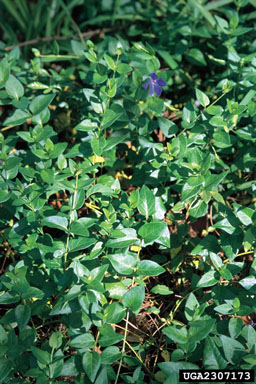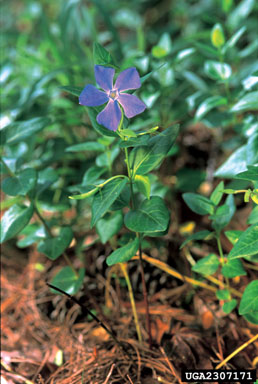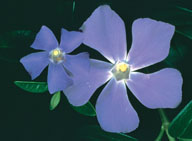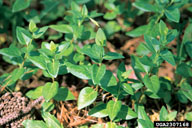|
Plant. Evergreen to semievergreen vines, somewhat woody, trailing or scrambling to 3 feet (1 m) long and upright to 1 foot (30 cm). Violet pinwheel-shaped flowers.
Stem. Slender (common periwinkle) to stout (bigleaf periwinkle), succulent becoming somewhat woody (tough to break) with flowering branches erect and jointed at axils. Hairless and smooth. Dark green at base to light green upward with a reddish tinge.
Leaves. Opposite. Glossy and hairless, somewhat thick, with margins slightly rolled under. Common periwinkle narrow elliptic, 0.8 to 1.8 inches (2 to 4.5 cm) long and 0.4 to 1 inch (1 to 2.5 cm) wide, with petioles 0.1 inch (1 to 3 mm) long. Bigleaf periwinkle heart-shaped to somewhat triangular to elliptic, 1.5 to 2.5 inches (4 to
6 cm) long and 1 to 1.5 inches (2.5 to 4 cm) wide, with petioles 0.2 to 0.4 inch (5 to 10 mm) long. Blades dark green with whitish lateral and midveins above and lighter green with whitish midveins beneath. Some varieties variegated.
Flowers. April to May (sporadically May to September). Axillary, usually solitary. Violet to blue lavender (to white), with five petals radiating pinwheel-like at right angles from the floral tube. Common periwinkle 1 inch (2.5 cm) wide with a 0.3- to 0.5-inch (8- to 12-mm) long tube. Bigleaf periwinkle 1.5 to 2 inches (4 to 5 cm) wide with a 0.6- to 0.8-inch (1.5- to 2-cm) long tube. Five sepals long lanceolate, about 0.4 inch (1 cm), hairy margined.
Fruit and seeds. May to July. Slender, cylindrical fruit to 2 inches (5 cm) long. Becoming dry and splitting to release three to five seeds.
Ecology. Found around old homesite plantings and scattered in open to dense canopied forests. Form mats and extensive infestations even under forest canopies by vines rooting at nodes, with viability of seeds yet to be reported.
Resemble partridgeberry, Mitchella repens L., which has cordate leaves, white twin flowers, and red berries. Also, may resemble yellow jasmine, Gelsemium sempervirens (L.) St. Hil., which has wider spaced leaves and reddish stems, often white waxy.
History and use. Introduced from Europe in 1700s. Ornamental ground cover, commonly sold and planted by gardeners.
|

Bigleaf periwinkle
April
Photo by J. Miller

Bigleaf periwinkle
April
Photo by J. Miller
|








